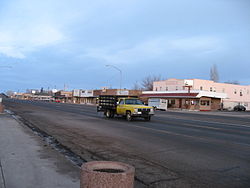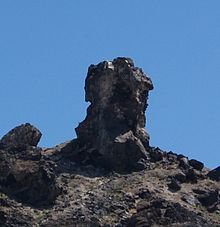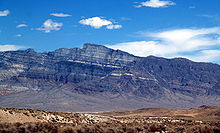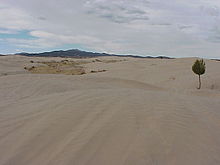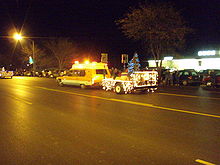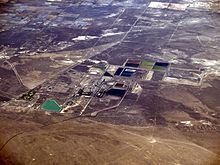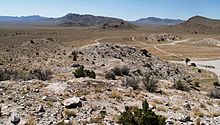- Delta, Utah
-
Delta, Utah — City — Location of Delta, UtahCoordinates: 39°21′11″N 112°34′25″W / 39.35306°N 112.57361°WCoordinates: 39°21′11″N 112°34′25″W / 39.35306°N 112.57361°W Country United States State Utah County Millard Settled 1906 Named for Delta of the Sevier River Area – Total 3.2 sq mi (8.2 km2) – Land 3.2 sq mi (8.2 km2) – Water 0.0 sq mi (0.0 km2) Elevation 4,639 ft (1,414 m) Population – Total 3,209 Time zone Mountain (MST) (UTC-7) – Summer (DST) MDT (UTC-6) ZIP code 84624 Area code(s) 435 FIPS code 49-18910[1] GNIS feature ID 1427334[2] Delta is a city in Millard County, Utah, United States. The population was 3,209 at the 2000 census.
Contents
Geography
Delta is located at 39°21′11″N 112°34′25″W / 39.353145°N 112.573656°W (39.353145, -112.573656).[3]
According to the United States Census Bureau, the city has a total area of 3.2 square miles (8.2 km2), all of it land.
Sevier River & Lake
The Sevier River flows near Delta. The Sevier River is generally used by irrigation before it reaches its eventual end, the dry Sevier Lake.
DMAD
DMAD are the initials for the Deseret Melville Abraham and Delta water company.
Just upstream of Delta, the Sevier River is dammed to provide irrigation water, reservoir storage, and cooling water for IPP, Intermountain Power Project. This reservoir is referred to as the DMAD.
Agriculture is a major economic force in Delta and the Sevier valley.
Gunnison Bend Reservoir
Downstream of Delta, the Sevier River is dammed again for irrigation and reservoir storage. This reservoir is named Gunnison Bend Reservoir, in honor of John Williams Gunnison.
Great Stone Face
One of the great icons of Delta is 'The Great Stone Face', which is a rock when viewed in profile appears Joseph Smith's face.[4]
Notch Peak
Notch Peak is located about 50 miles to the west of Delta. The skyline appears to have a notch taken out of it when viewed from Delta.
Little Sahara Sand Dunes
Little Sahara is about 25 miles North of Delta. It is a very popular area for ATV riders. For more information, see Little Sahara Recreation Area.
Demographics
Historical populations Census Pop. %± 1920 939 — 1930 1,183 26.0% 1940 1,304 10.2% 1950 1,703 30.6% 1960 1,576 −7.5% 1970 1,610 2.2% 1980 1,930 19.9% 1990 2,998 55.3% 2000 3,209 7.0% As of the census[1] of 2000, there were 3,209 people, 1,006 households, and 780 families residing in the city. The population density was 1,018.3 people per square mile (393.3/km2). There were 1,106 housing units at an average density of 351.0 per square mile (135.6/km2). The racial makeup of the city was 94.61% White, 0.06% African American, 0.97% Native American, 0.12% Asian, 0.28% Pacific Islander, 3.15% from other races, and 0.81% from two or more races. Hispanic or Latino of any race were 10.10% of the population.
There were 1,006 households out of which 48.6% had children under the age of 18 living with them, 65.3% were married couples living together, 9.0% had a female householder with no husband present, and 22.4% were non-families. 20.8% of all households were made up of individuals and 10.2% had someone living alone who was 65 years of age or older. The average household size was 3.15 and the average family size was 3.71.
In the city the population was spread out with 38.7% under the age of 18, 8.2% from 18 to 24, 24.3% from 25 to 44, 18.1% from 45 to 64, and 10.7% who were 65 years of age or older. The median age was 28 years. For every 100 females there were 103.4 males. For every 100 females age 18 and over, there were 94.9 males.
The median income for a household in the city was $37,773, and the median income for a family was $43,952. Males had a median income of $37,340 versus $21,369 for females. The per capita income for the city was $13,273. About 10.1% of families and 13.0% of the population were below the poverty line, including 16.5% of those under age 18 and 5.4% of those age 65 or over.
Economy
Intermountain Power Project (IPP)
One of the main sources of income for Delta is a power plant called operated by the Intermountain Power Agency and known as the Intermountain Power Project or I.P.P. It is also referred to as Intermountain Power Service Corporation or I.P.S.C. This coal-powered power plant supplies power for much of Los Angeles county in California. The plant was originally designed for 4 units, but only 2 have been built. Each unit produces 900 megawatts of electricity.
Brush Wellman
Brush Wellman is a mine and refining plant located at one of the few sources of concentrated beryllium in the world. The plant is a mill and finishing facility for beryllium, a high-strength, lightweight metal used in military, aerospace, and medical industries. The ore for the plant comes from Brush Wellman's mine, located in the Topaz-Spor Mountains, 50 miles west, which is North America's only developed source for the metal. The facility is located here due to the remoteness of the area, as beryllium dust is highly toxic, and the proximity of a large source of power: the Intermountain Power Project.
Graymont Lime
Graymont Lime has a plant in the Cricket Mountains, about 35 miles southwest of Delta. It is one of the 10 largest lime plants in the United States. It was previously owned by Continental Lime which was purchased by Graymont Lime. For more information, see Graymont's website.
Alfalfa
Alfalfa hay is the main crop of the Delta area. Because of Delta's dry climate, the farmers are able to control the alfalfa hay's moisture when it is baled. This is very important to prohibit mold growth.
Dairy
Delta is home to many dairy farmers who may ship the milk out of the county, or may ship it to the local cheese factory (Red Rock Specialty Cheese).
Science
Cosmic Ray Center
Delta is home to the Lon and Mary Watson Cosmic Ray Center, the main staging area for the Telescope Array experiment.[5]
Fossils & Minerals
A great attraction of Millard County's economy is the digging of fossils. Trilobite fossils are relatively common in the region west of Delta (part of the House Range's Wheeler Shale). A number of local companies maintain fossil dig areas where they allow visitors to dig their own fossils for a small fee.
Near Delta is a mountain called Topaz Mountain which derives its name from the Topaz that is abundant in the area. Other minerals and rocks that are prevalent near Delta include Obsidian, Opal, and geode.
History
Settlement of Delta began in 1907 on townlots that had been laid out in 1906.[6] The town was originally called Burtner.
Topaz Relocation Camp
After the attack on Pearl Harbor, many Japanese-Americans were gathered up and placed in concentration camps with the intention of protecting military installations from espionage. One of these camps was located near Delta. For more information see Topaz War Relocation Center.
Great Basin Museum
A history of the area is kept and displayed at The Great Basin Museum. For more information, see Great Basin Museum
Gunnison Massacre Site
John Williams Gunnison was leading a federal surveying team near the Sevier Lake. He was ambushed by the Pahvant Indians and killed.
Entertainment
Snow Goose Festival
The Snow goose Festival occurs every winter as the geese migrating through Delta stop at Gunnison Bend Reservoir. For more information on the Snow Goose Festival, see http://www.deltagoosefestival.info/
Demolition Derby
Each 4 July the Hinckley Lions Club sponsors a demolition derby at the Millard County Fairgrounds. The derby attracts an extraordinarily large crowd in excess of 3,000 people. It is one of the largest derbies in the United States with up to eleven rounds of competition including pickup trucks, figure 8 compact car competition, powder puff, a championship round and a wipe out round. Following the derby, there is a fireworks display sponsored by Delta City.
Days of the Old West Rodeo
A Professional Rodeo Cowboys Association (PRCA) Rodeo every year. See Days of the Old West PRCA Rodeo for more information.
References
- ^ a b "American FactFinder". United States Census Bureau. http://factfinder.census.gov. Retrieved 2008-01-31.
- ^ "US Board on Geographic Names". United States Geological Survey. 2007-10-25. http://geonames.usgs.gov. Retrieved 2008-01-31.
- ^ "US Gazetteer files: 2010, 2000, and 1990". United States Census Bureau. 2011-02-12. http://www.census.gov/geo/www/gazetteer/gazette.html. Retrieved 2011-04-23.
- ^ For more information, please see The Great Stone Face - Millard County.
- ^ Cosmic Ray Center Dedicated
- ^ Andrew Jenson. Encyclopedic History of the Church. (Salt Lake City: Deseret Book, 1941) p. 179
External links
Municipalities and communities of Millard County, Utah Cities Delta | Fillmore
Towns CDP Unincorporated
communitiesGhost towns Categories:- Cities in Utah
- Populated places in Millard County, Utah
- Populated places established in 1907
Wikimedia Foundation. 2010.

